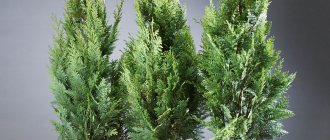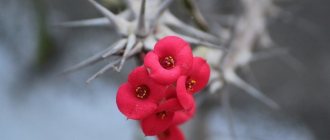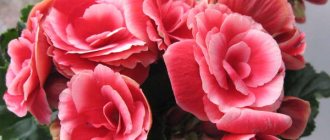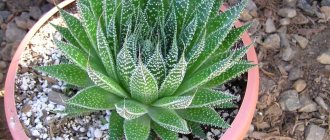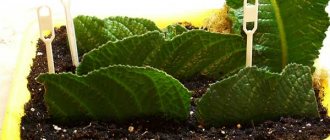A beautiful indoor Radermacher tree, a photo of which can be seen below, is very popular among domestic flower growers.
This culture does well at home.
Radermachera is easy to care for and has lush glossy foliage, which allows the flower to fit perfectly into any room interior.
general information
Radermachera (lat. Radermachera) got its name in honor of the Dutch scientist who found it in the forests of Southeast Asia. It belongs to the Bignoniaceae family and has 16 species in the genus. In the natural environment it lives up to 20–30 years, but even at home it can delight the owner for decades.
Expert opinion
Mokhov Andrey Petrovich
Graduated from KubSAU, specialty: agronomy
Chinese Radermachera (Radermachera sinica) is the only representative of the genus among indoor plants.
You can buy Radermachera online or at a flower shop. The price depends on the size and starts from 500 rubles for a tree 20–25 cm high. A plant about a meter in height will cost about 2,500 rubles.
The china tree is similar in appearance to ash, ficus, hibiscus, laurel and coffee tree.
The snake tree, despite its name, is not poisonous. Moreover, it perfectly purifies the air.
Main types
The Radermacher genus includes about 17 species, but only 3 species are the most popular:
- Radermachera arboreal - a tree that grows up to 5–10 m and is found in Indian forests with low humidity. This species attracts with its flowering crown. Among the lush greenery, thick branches and trunk, small inflorescences of buds bloom, which have the shape of a cone. The petals of the flower are bent. Their snow-white texture has a wide wavy border. The pharynx has a creamy-yellow hue.
- Radermacher fiery red is a tree that has a carved crown and leaves no more than 7 cm long. A feature of this species is the appearance of flower buds that form on the branches and trunk. The cluster of inflorescences is topped with orange-red flowers, which are shaped like a tube. Their edges are protruding, and the flowers themselves exude pleasant notes of jasmine.
- Radermachera chinensis or sinica - the only species that grows as a house flower. This is a shrub, the height of which varies from 1.5 to 2 m, crowned with a lush crown. The branches have groups of dark green leaves. An interesting variety of this species is Radermachera sinica Caprima, which combines dark green and light green flowers, which forms a unique mosaic coloring of the crown.
Photo gallery
It has a main trunk and several horizontal shoots that become woody over time. Their surface is smooth and covered with gray-green bark.
A distinctive feature of Radermachera are the “lentils” - small oval thickenings on the branches.
Long oval or ovoid leaves grow close to each other. They are glossy with jagged edges. Initially they have a light green color, but over time they darken from the middle.
The emerald tree almost never blooms indoors. The first buds on it can be seen only after 10–15 years. In the wild, they appear in the summer directly on the trunk or in the axils of the leaves and are very similar to bells. The color is white, cream or yellow-orange.
Expert opinion
Mokhov Andrey Petrovich
Graduated from KubSAU, specialty: agronomy
The flowers open only at night and emit the scent of cloves, cinnamon or jasmine.
Signs and superstitions
Radermacher absorbs negative energy and helps you focus on important things. It is believed that the tree activates the spiritual chakras and opens channels of communication with a higher power, therefore it is suitable for people engaged in spiritual practices.
Is your Radermacher growing?
If a plant dies unexpectedly, it is believed that it has warded off a strong evil eye from its owner. According to Feng Shui, indoor ash has a beneficial effect on the atmosphere of the home. It is also a symbol of education.
Radermacher cannot tolerate tobacco smoke.
How to form a radermachera in bonsai style
- Plant it in a small container (take not very fertile soil).
- Apply fertilizers rarely and in minimal quantities.
- When replanting, trim the roots.
- Remove excess side shoots, buds and twigs.
- Twist, bend and weight the branches using weights and wire until they become woody.
- Turn the plant with different sides towards the light so that the crown is formed evenly.
- Cut the bark to age the tree.
Carry out all procedures for forming a tree in the spring and summer and only after it has strengthened in the pot.
Pruning of branches and roots should be aimed at balancing the proportions of the bonsai above and below ground.
Watering rules
For normal development, Radermachera requires well-moistened soil. Water the plant frequently and deeply. Don't wait until the top layer of soil is completely dry.
Also, do not allow water to accumulate around the plant’s root system. Be sure to make a drainage layer in the pot. Water the Radermacher with clean, pre-settled water.
Home care
Caring for an emerald tree does not require a lot of time and effort. The main thing is good lighting and proper care, which has seasonal characteristics.
| Season | Temperature | Humidity | Lighting |
| Spring | 20–22˚С, no drafts, diffused light. | Increased | Bright diffused light. Avoid direct sunlight. |
| Summer | |||
| Autumn | Not lower than 10–13˚С. Optimally 16–18˚С. No drafts. | Adapts to dry air | The brightest place. You need to use phytolamps. |
| Winter |
Winter is the tree's dormant period.
Radermachera grows best in moderate humidity to provide it with the right conditions:
- place the pot in a tray with damp expanded clay, sphagnum or pebbles;
- spray leaves in hot weather;
- Once every 10 days, give the plant a cool shower (cover the ground with polyethylene).
Expert opinion
Mokhov Andrey Petrovich
Graduated from KubSAU, specialty: agronomy
When immersing the pot in expanded clay, moss or pebbles, make sure that the bottom does not touch the water.
The plant loves bright, diffused light. Therefore, place it on southwest or southeast windows. In this case, the leaves should not touch the glass. When placing the tree in the south, make sure that direct sunlight does not fall on it.
Ambient temperature, humidity
From early spring to late autumn, indoor ash requires warm air. Its temperature should not drop to 20 degrees. In winter, the plant feels more comfortable if the ambient temperature is between 10 and 14 degrees.
At the same time, both in winter and summer, the air in the room where this tree grows must be regularly ventilated. Do not forget that Radermachera does not tolerate drafts - when ventilating the room, protect the plant from them.
Chinese Radermachera is undemanding to ambient humidity. Even in a room with dry air it will develop normally. But you will only make it better if you occasionally spray it with warm water from a spray bottle.
It's also a good idea to give her a warm shower. During such bathing, cover the top of the pot with a bag so as not to over-moisten the soil. In winter, spray and bathe Radermacher Kuminga occasionally. Do not rush to return the pot with the plant to the cold window glass - let it dry.
Pruning and crown formation
Radermachera grows quickly, so it needs regular pruning and pinching of shoots. The procedures are carried out in mid-April. At this time, the longest branches are cut by 1/3, and thin and elongated shoots are removed. If you additionally remove the side branches, exposing the main trunk, the plant will take on the shape of a tree.
If you regularly pinch the upper buds, it will look like a lush bush. There is another way of pruning - to a stump. This is a drastic measure, but the plant tolerates it well and soon produces new shoots.
Priming
Indoor ash needs loose, fertile soil. You can prepare it yourself: mix turf and leaf soil, peat and humus in a ratio of 1:2:1:1. Add a handful of coarse sand, agroperlite, vermiculite or crushed pine bark.
Expert opinion
Mokhov Andrey Petrovich
Graduated from KubSAU, specialty: agronomy
Before planting the plant in a homemade substrate, disinfect it by heating or freezing.
But it is better to use ready-made soil for decorative foliage plants (roses, citrus fruits or palm trees). Indeed, in this case, the quality of the mixture will be much higher, and the risk of infecting the plant from the soil is minimal.
Radermachera can grow on a nutrient solution.
Video: Radermachera chinensis - the best plant for offices and novice gardeners
Flower growers who take the time to create and maintain an optimal microclimate and properly care for it are pleased with Radermacher, forming a “cap” of dark green shiny leaves. Such a flower will not get lost in the largest collection of indoor plants, also because of its size. Radermachera looks great in spacious rooms, but this does not mean that it cannot be grown in a small apartment.
- Author: Yulia Golova
27 years old, higher legal education, broad outlook and interest in a variety of topics. Rate this article:
- 5
- 4
- 3
- 2
- 1
(2 votes, average: 3 out of 5)
Share with your friends!
Transfer
Transplantation is carried out in the spring. Young plants undergo this procedure annually, adults - once every 2-3 years. You can determine that the Radermacher plant needs a new pot by its roots: they will entwine the entire container and will be visible from the drainage hole.
The plant must also be replanted 2–3 weeks after purchase. He needs this time to acclimatize in the apartment.
- Prepare the pot in advance: rinse the old one well or soak the new one in water for several hours.
- Stir the soil 2 hours before planting to saturate it with oxygen.
- Water the plant generously the previous day.
- Place 3 cm of expanded clay drainage at the bottom of the pot.
- Lay out a small layer of soil.
- Remove the radermachera from the old pot along with the soil.
- Remove old and damaged roots; in adult plants, cut them by 1/3.
- Treat the cuts with a fungicide or crushed charcoal.
- Transfer the tree along with a lump of earth into a new pot.
- Add new soil.
- Water it.
After transplanting, place the pot in partial shade. The plant will look lethargic for the first few days, but will recover later. After that, move it to its usual place.
Reproduction. Table
The emerald tree reproduces vegetatively or generatively . The first method is mainly used because the seeds are almost impossible to obtain on your own. However, they are found in some flower shops.
| Seeds | By layering | Cuttings |
| 1. Distribute the seeds over the soil. 2. Spray. 3. Cover with film or glass. 4. Leave in a warm place for 10–15 days. 5. After germination, remove the covering. 6. After 15–20 days, transplant the sprouts into separate containers. | 1. Make a cut on the trunk. 2. Apply wet sphagnum moss. 3. Wrap in plastic. 4. Ventilate the incision site daily. 5. Spray the moss. 6. Replant the branch after its roots cover the entire surface of the film. | 1. In May or June, cut off the shoot at a height of 8–10 cm. 2. Choose a shoot with at least one leaf and an internode. 3. Plant the cuttings in a damp mixture of peat and sand. 4. Set up a mini-greenhouse. 5. Ventilate and moisten once a day. |
Expert opinion
Mokhov Andrey Petrovich
Graduated from KubSAU, specialty: agronomy
In the place where the seedlings are located, maintain a temperature of 20˚C.
Fertilizer and feeding
Feeding in the spring-summer period is carried out twice a month. With the onset of autumn it is gradually reduced to nothing. In winter, the plant is not fed. It is recommended to apply fertilizer only a few hours after watering, so as not to burn the roots.
From April to August, feed the Radermacher with a complex fertilizer for ornamental foliage plants, for example, Kemiroy Lux, Agricola, Etisso.
Do you use fertilizers or flower food?
Problems with leaves. Table
| Signs | Causes | Solution |
| They fall off, and the shoots become thinner and longer | Little light | Move, use phytolamps to extend daylight hours. |
| Become small and dull | Lack of nutrition | Fertilize or replant. |
| Wither | Under or over watering | In the first case - water, in the second - replant. |
| The ends dry out | Low humidity | Spray or place in a tray with damp expanded clay. |
If you are going on vacation
There are two ways to save a tree while you are away. The first is to ask relatives or friends, the second is to purchase or design an automatic watering system. To enhance the effect:
- put all the plants in one place;
- create partial shade in the room;
- Water thoroughly;
- cover the pots with wet expanded clay;
- thin out the leaves.
Difficulties in growing
Emerging problems with the plant arise mainly when the maintenance conditions are violated:
- From excessive watering, the tops of the shoots begin to rot and the leaves turn yellow.
- Lack of lighting affects the shape and beauty of Radermachera - the leaves become small, the crown becomes elongated. It is even possible to shed leaves, sometimes completely. It is urgent to rearrange the pot, and the tree will recover.
- Dryness and insufficient watering will affect the beauty of the leaves - they become sluggish and lifeless.
Diseases and pests. Table
| Diseases and pests | Signs | Causes | Prevention and treatment |
| Root rot | Black spots on the stem from the base. At the same time, it becomes soft. | Waterlogging, low temperatures. | Replant in soil treated with a fungicide and remove damaged roots. |
| Spider mite | Cobwebs on the leaves, they curl and dry out. | Remove damaged leaves and treat with Aktara or Fufanon. | |
| Aphid | Deformation of shoots, there are green insects on the plant. | Wash the plant with a mild soap solution. Treat with Actellik. | |
| Mealybug | Sticky dirty white balls on leaves. | Carry out 3 treatment procedures with Aktara at weekly intervals. | |
| Shchitovka | The shoots turn yellow and become deformed, the leaves dry out. | Insufficient humidity and elevated temperature. | Wash the leaves with soapy water. Treat with Fitoverm and Actellik. |
Radermachera will complement any interior with its bright emerald glossy foliage. In addition, a neat tree looks very stylish. And since it feels great indoors, you don’t have to take special care of it.
general description
The homeland of the plant in question is considered to be the southeastern part of Asia. The flowers belong to the begoniaceae family. There are 16 varieties of such crops in the world, but only Radermachera sinensis can develop in indoor conditions. Under natural conditions in its homeland, this plant takes on the appearance of an evergreen tree. Under favorable conditions, its height can reach 30 meters.
The plant was first described in the 18th century by the Danish scientist Jacob Radermacher.
